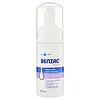What's inside
What's inside
 Key Ingredients
Key Ingredients

 Benefits
Benefits

 Concerns
Concerns

 Ingredients Side-by-side
Ingredients Side-by-side

Water
Skin ConditioningDisodium Laureth Sulfosuccinate
CleansingCocamidopropyl Betaine
CleansingSodium C14-16 Olefin Sulfonate
CleansingPropylene Glycol
HumectantPEG-150 Distearate
EmulsifyingAlcohol
AntimicrobialAloe Barbadensis Leaf Extract
EmollientBenzyl Salicylate
PerfumingCalendula Officinalis Flower Extract
MaskingCitric Acid
BufferingHexyl Cinnamal
PerfumingMagnesium Chloride
Magnesium Nitrate
Methyl Gluceth-20
HumectantMethylchloroisothiazolinone
PreservativeMethylisothiazolinone
PreservativeMethylparaben
PreservativeSodium Chloride
MaskingSodium Hydroxide
BufferingTetrasodium EDTA
CI 42090
Cosmetic ColorantParfum
MaskingWater, Disodium Laureth Sulfosuccinate, Cocamidopropyl Betaine, Sodium C14-16 Olefin Sulfonate, Propylene Glycol, PEG-150 Distearate, Alcohol, Aloe Barbadensis Leaf Extract, Benzyl Salicylate, Calendula Officinalis Flower Extract, Citric Acid, Hexyl Cinnamal, Magnesium Chloride, Magnesium Nitrate, Methyl Gluceth-20, Methylchloroisothiazolinone, Methylisothiazolinone, Methylparaben, Sodium Chloride, Sodium Hydroxide, Tetrasodium EDTA, CI 42090, Parfum
Water
Skin ConditioningAlumina
AbrasiveCetearyl Olivate
Sorbitan Olivate
EmulsifyingHydrogenated Vegetable Oil
EmollientCanola Oil
EmollientCetearyl Alcohol
EmollientDimethicone
EmollientHydrogenated Olive Oil
Skin ConditioningCetyl Alcohol
EmollientMethyl Gluceth-20
HumectantOlea Europaea Fruit Oil
MaskingButyrospermum Parkii Butter
Skin ConditioningGlyceryl Behenate
EmollientButylene Glycol
HumectantPhenoxyethanol
PreservativeParfum
MaskingXanthan Gum
EmulsifyingAllantoin
Skin ConditioningOlea Europaea Oil Unsaponifiables
Skin ConditioningDisodium EDTA
Propylene Glycol
HumectantPentaerythrityl Tetra-Di-T-Butyl Hydroxyhydrocinnamate
AntioxidantOcimum Sanctum Leaf Extract
Skin ConditioningBisabolol
MaskingSilybum Marianum Fruit Extract
Skin ConditioningCI 11680
Cosmetic ColorantMethylisothiazolinone
PreservativeSilica
AbrasiveCI 77491
Cosmetic ColorantPotassium Sorbate
PreservativeCI 42090
Cosmetic ColorantCitric Acid
BufferingLimonene
PerfumingCitral
PerfumingWater, Alumina, Cetearyl Olivate, Sorbitan Olivate, Hydrogenated Vegetable Oil, Canola Oil, Cetearyl Alcohol, Dimethicone, Hydrogenated Olive Oil, Cetyl Alcohol, Methyl Gluceth-20, Olea Europaea Fruit Oil, Butyrospermum Parkii Butter, Glyceryl Behenate, Butylene Glycol, Phenoxyethanol, Parfum, Xanthan Gum, Allantoin, Olea Europaea Oil Unsaponifiables, Disodium EDTA, Propylene Glycol, Pentaerythrityl Tetra-Di-T-Butyl Hydroxyhydrocinnamate, Ocimum Sanctum Leaf Extract, Bisabolol, Silybum Marianum Fruit Extract, CI 11680, Methylisothiazolinone, Silica, CI 77491, Potassium Sorbate, CI 42090, Citric Acid, Limonene, Citral
Ingredients Explained
These ingredients are found in both products.
Ingredients higher up in an ingredient list are typically present in a larger amount.
Ci 42090 is a synthetic dye created from petroleum. It is used to give a bright blue color to cosmetics, medicine, and food.
Citric Acid is an alpha hydroxy acid (AHA) naturally found in citrus fruits like oranges, lemons, and limes.
Like other AHAs, citric acid can exfoliate skin by breaking down the bonds that hold dead skin cells together. This helps reveal smoother and brighter skin underneath.
However, this exfoliating effect only happens at high concentrations (20%) which can be hard to find in cosmetic products.
Due to this, citric acid is usually included in small amounts as a pH adjuster. This helps keep products slightly more acidic and compatible with skin's natural pH.
In skincare formulas, citric acid can:
While it can provide some skin benefits, research shows lactic acid and glycolic acid are generally more effective and less irritating exfoliants.
Most citric acid used in skincare today is made by fermenting sugars (usually from molasses). This synthetic version is identical to the natural citrus form but easier to stabilize and use in formulations.
Read more about some other popular AHA's here:
Learn more about Citric AcidMethyl Gluceth-20 is a humectant. Humectants help draw moisture from the air to your skin.
It is created by combining polyethylene glycol with glucose.
MI is a preservative and known skin irritant. In the past, MI was used for its ability to prevent bacteria, yeast, and fungi growth in low doses.
Nowadays, you'll most likely see MI combined with Methylchloroisothiazolinone (MCI). Trade names for this combination include Kathon CG or Euxyl K 100.
Since then, numerous studies have shown this ingredient to cause contact dermatitis, or skin irritation.
The use of this ingredient varies around the world:
Learn more about MethylisothiazolinoneParfum is a catch-all term for an ingredient or more that is used to give a scent to products.
Also called "fragrance", this ingredient can be a blend of hundreds of chemicals or plant oils. This means every product with "fragrance" or "parfum" in the ingredients list is a different mixture.
For instance, Habanolide is a proprietary trade name for a specific aroma chemical. When used as a fragrance ingredient in cosmetics, most aroma chemicals fall under the broad labeling category of “FRAGRANCE” or “PARFUM” according to EU and US regulations.
The term 'parfum' or 'fragrance' is not regulated in many countries. In many cases, it is up to the brand to define this term.
For instance, many brands choose to label themselves as "fragrance-free" because they are not using synthetic fragrances. However, their products may still contain ingredients such as essential oils that are considered a fragrance by INCI standards.
One example is Calendula flower extract. Calendula is an essential oil that still imparts a scent or 'fragrance'.
Depending on the blend, the ingredients in the mixture can cause allergies and sensitivities on the skin. Some ingredients that are known EU allergens include linalool and citronellol.
Parfum can also be used to mask or cover an unpleasant scent.
The bottom line is: not all fragrances/parfum/ingredients are created equally. If you are worried about fragrances, we recommend taking a closer look at an ingredient. And of course, we always recommend speaking with a professional.
Learn more about ParfumPropylene Glycol is an odorless, colorless liquid. As a humectant, it helps skin retain moisture. It also aids in delivering active ingredients.
Another role of this ingredient is preventing a product from melting or freezing. Propylene glycol also adds antimicrobrial properties to a product, elongating product lifespan.
This ingredient is considered an organic alcohol and commonly added into both cosmetics and foods.
Those with sensitive skin or conditions may develop a rash when using this ingredient.
Learn more about Propylene GlycolWater. It's the most common cosmetic ingredient of all. You'll usually see it at the top of ingredient lists, meaning that it makes up the largest part of the product.
So why is it so popular? Water most often acts as a solvent - this means that it helps dissolve other ingredients into the formulation.
You'll also recognize water as that liquid we all need to stay alive. If you see this, drink a glass of water. Stay hydrated!
Learn more about Water